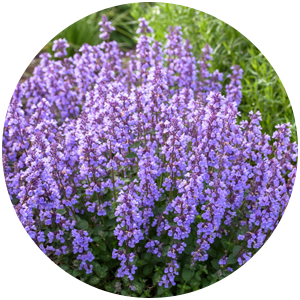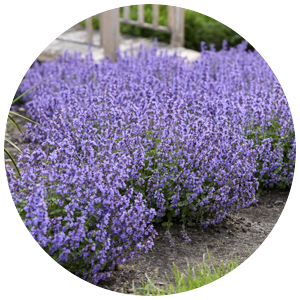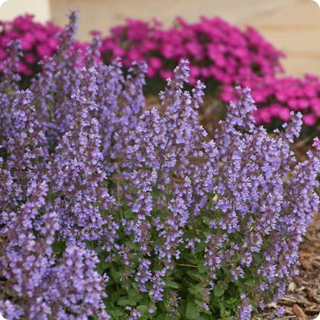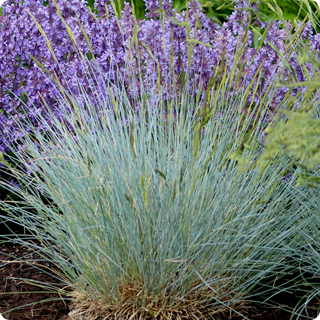‘CAT’S PAJAMAS’
NEPETA
The Purrfect Perennial for Your Hot, Sunny Landscape
- Showy, easy care perennial for landscapes
- Vibrant blue flowers from top to bottom
- Attracts loads of pollinators
- Deer and rabbit resistant
- Thrives in all-day sunshine
- 12-14” tall x 18-20” spread
- Perennial in USDA Zones 3-8
- Pronounced “NEP-it-uh”
If you’ve ever grown catmint and were disappointed in how it split open and oozed over onto its neighbors, we have good news! ‘Cat’s Pajamas’ will be the most well-behaved catmint you’ve ever seen. Its shape is like a blue bowling ball in the landscape—neatly rounded and covered top to bottom for most of the summer in bubbly blue blossoms. You’ll find that it starts blooming a bit earlier than most catmints, too.
Use this plant to create a tidy, colorful border around your veggie garden where visiting bees will make regular visits and help boost your yields. Or line your front border with a ribbon of this blue beauty and admire it every time you walk outside. There are endless uses for this easy-to-grow, hardy perennial.
HOW TO GROW ‘CAT’S PAJAMAS’ NEPETA

Planting
Look around your landscape to find a relatively dry spot where there is abundant sunshine. That’s where you will want to plant ‘Cat’s Pajamas’. Its tough constitution means it prefers not to be pampered, so save your energy for more needy plants. This one can handle the sun, heat, moderate drought and critter pressure all on its own.
If you’re the kind of person who likes to mix compost and other nutrient-rich ingredients into the soil when planting, know that this perennial will not appreciate that extra step. It will actually grow better in poorer soils that are lacking a high concentration of organic matter. Alkaline to neutral pH soils are preferable, but the only real requirement is that the soil be well-drained. This plant’s roots do not like to sit wet for long, especially in winter.
Choose a location that receives abundant sunshine—a minimum of six hours per day with most of that coming in the afternoon. Catmint does not need any shade, even in warm climates. Too much shade, too much water, or too rich soil will make it split open.
‘Cat’s Pajamas’ is a very durable perennial that can be planted in either spring or fall. If the roots are densely circled around when you take the plant out of the pot, loosen them up a bit to break the “root memory”. This will encourage them to grow outward instead of continuing to grow in a circular pattern.
If you have heavy clay soil, choose a higher part of your garden or a raised bed to plant your catmint. This plant does not tolerate wet, heavy soil. Amending your clay soil with soil conditioner or finely shredded bark will help to improve the drainage. Set the plant in the hole, making sure that the top of the rootball is level with the top of the surrounding soil, then backfill the hole. Press it down with your hand firmly to eliminate any big air pockets around the roots.
Once planted, water the plant to help the soil settle. The first season while it is getting established, it will need a little more water than in subsequent years. Once its roots are anchored in, they will be able to seek the available moisture from the soil, making the plant self-sufficient.

Maintenance
Once you have ‘Cat’s Meow’ planted in the right place, little care is needed. This truly is a low maintenance perennial.
The most important thing to remember about caring for this plant is not to give it too much love. Overwatering or overfeeding can lead to its demise. If your plant is yellowing, stretching or flopping, it is likely getting too many nutrients, not enough sun, or too much water. In late fall or early spring, shear the plant back to the ground to make room for the new growth.
‘Cat’s Meow’ displays its first round of blossoms in late spring to early summer, typically 2-3 weeks earlier than other catmints. Once those flowers are spent, likely sometime around midsummer, shear the entire plant back by about half. This will stimulate fresh new growth and new batch of blooms that can last until fall.
No fertilizer is necessary unless you garden in very sandy soil that is nearly completely devoid of nutrients. In such a case, a small amount of slow release plant food like Espoma’s Plant-tone can be applied in spring once the plant begins to grow. No other plant food should be needed.
Because of its aromatic foliage, few pests, including deer and rabbits, ever bother catmint. However, you may find that your cat enjoys a nibble from time to time.

Companion plants
When you are deciding what to plant with your new catmint, look first for plants that enjoy similar growing conditions—namely, plants that prefer full sun, lower moisture levels and lean soil.
Keep in mind that this is a perennial that takes a couple of years to really mature. Though the plants you put into your garden may be small the first year, they often return double the size the following year. Take care not to plant it too close to its neighbors or you will need to do some transplanting in subsequent seasons.

Cat’s Pajamas Nepeta & ‘Paint the Town Fuchsia’ Dianthus
Since ‘Cat’s Pajamas’ blooms first from late spring or early summer into midsummer, you could choose to plant it with other perennials that bloom in the same relative timeframe like ‘Paint the Town Fuchsia’ Dianthus (shown above). This duo will bring a blast of color to your garden in the first half of the growing season. Later blooming perennials like daylilies also make good companions for when ‘Cat’s Pajamas’ is showing off its second round of flowers in mid to late summer.
Blue fescue grass (shown below) makes a fun planting partner for ‘Cat’s Pajamas’ because the two share a similar overall shape and cool color palette. The blue tones of the grass continue the look even when the catmint isn’t in bloom.
To really make its blue flowers pop, you’ll want to plant something taller in contrasting color behind ‘Cat’s Pajamas’. Yellows and purples make especially pretty neighbors. You might like it with the gold-flowered ‘Tuscan Sun’ perennial sunflower or Spilled Wine® weigela.
TOP 3 REASONS TO GROW
‘CAT’S PAJAMAS’ NEPETA
SO MUCH COLOR FOR SO LITTLE EFFORT
Even with little care, this perennial blooms its pretty little head off for months beginning in late spring.
SUPPORT LOCAL POLLINATORS
Nearly every day, you will find pollinating bees and maybe a hummingbird or two stopping by these flowers for a midday snack.
IT’S NEAT AND TIDY
Unlike some larger catmints, ‘Cat’s Pajamas’ won’t split open and smother its neighbors or use up too much real estate in the garden.
‘Cat’s Pajamas’ Nepeta USPP31127 CanPBRAF



